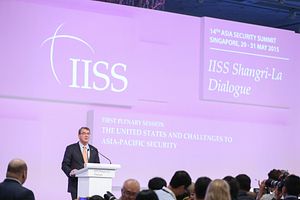SINGAPORE – This weekend, the 2017 iteration of the Shangri-La Dialogue (SLD) – Asia’s premier security dialogue organized by the British think tank the International Institute for Strategic Studies (IISS) – will be held in Singapore (See: “The State of Asia’s Security Dialogues”).
This year’s SLD will see attendance from defense ministers from the United States, Australia, Canada, France, Indonesia, Japan, Malaysia, New Zealand, and the Philippines, with other countries sending various levels of representation as well. It will adopt a similar structure of plenary sessions run on Saturday and Sunday with speaking slots for the ministers – with subjects ranging from defense policy to crisis management – as well as special sessions examining issues like nuclear issues and emerging technologies. Australian Prime Minister Malcolm Turnbull will deliver the keynote address on Friday night to kick off SLD 2017.
In terms of areas of focus in the official deliberations (as opposed to the countless official and unofficial meetings that take place on the sidelines), much of the attention this year is likely to be on U.S. Asia policy. To be sure, it is rare that Washington’s perspective does not grab the headlines at the SLD whether it be for its own sake or in the context of U.S.-China relations, as I wrote after listening to U.S. Defense Secretary Ash Carter’s remarks at last year’s dialogue (See: “US Hits Right Note At Shangri-La With Principled Security Network”). But interest in the United States will be especially so this year considering the uncertainty that President Donald Trump’s election has produced among some in the region (See: “The Real Challenge for US-ASEAN Relations Under Trump”).
In that sense, all eyes will be on the speech that U.S. Defense Secretary James Mattis will deliver during the first of the five plenary sessions on Saturday morning. This is despite the fact that Mattis represents but one perspective on U.S. policy in an administration that is barely six months in office, with most of its senior positions still unfilled and with many lingering questions about the direction of its overall domestic and foreign policy as well as the centers of power and how they factor into decisionmaking.
The SLD also offers an opportunity to “take the temperature” of the region on certain security issues, as IISS Director General and Chief Executive John Chipman put it in a preview earlier this week, particularly on major flashpoints like the South China Sea or North Korea. Discussion among the delegates at last year’s SLD was unsurprisingly focused on the South China Sea, given the fact that the dialogue occurred just weeks before the much-anticipated arbitral tribunal hearing on the Philippines’ case against China in July (See: “Does the Philippines’ South China Sea Case Against China Really Matter?”).
This year, the South China Sea will no doubt continue to be in the spotlight, especially within the context of the rules-based order, which is the subject of one of the plenary sessions. Though the headlines have tended to focus on the about-face in the Philippines’ position after Rodrigo Duterte assumed the presidency, in reality he has merely exposed the more enduring challenges that Manila along with ASEAN and outside actors like the United States had all been grappling with even before he came to power (See: “The Truth About Duterte’s ASEAN South China Sea Blow”).
But given what we have seen over the past few months – from the battery of missile tests Pyongyang has been conducting to the bold assassination of Kim Jong-nam in Malaysia – North Korea is likely to be a hot topic too (See: “The Myth of a North Korea-Malaysia Special Relationship”). And as I have noted before, the SLD also tends to see focus on other issues and areas as well even though they are not reflected in media commentary about the deliberations, be it the Islamic State or even the Sulu Sea, where trilateral patrols have been forged by Malaysia, Indonesia, and the Philippines (See: “Confronting Threats in the Sulu-Sulawesi Seas: Opportunities and Challenges”).
The SLD prides itself on being not just a forum for discussing issues, but also debating and developing potential solutions to ongoing regional challenges in a substantive way. This will continue to be the case this year as well during the dialogue as a whole, though there is also a plenary session dedicated to finding common ground on regional security and a special session on practical measures to avoid conflict at sea.
There will no doubt be much to be deliberated here too, from the ‘progress’ being touted by China on the ever-elusive code of conduct with ASEAN states on the South China Sea to incremental initiatives designed to reduce incidents at sea such as the Code for Unplanned Encounters at Sea (CUES), a series of naval protocols for the safety of naval vessels first enacted at the Western Pacific Naval Symposium back in 2014 that is being tested with proposals for its expansion (See: “Where is Singapore’s New Underwater Naval Protocol?”).

































